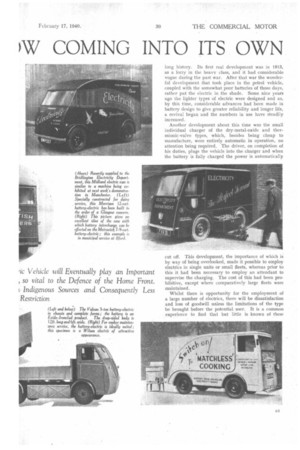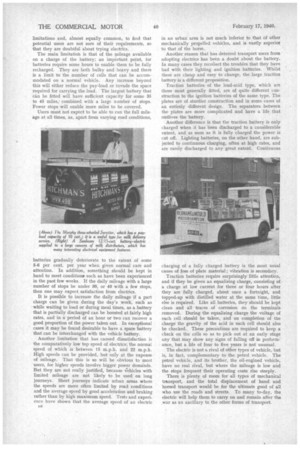THE BATTERY-ELECTRIC IS I
Page 30

Page 31

Page 32

If you've noticed an error in this article please click here to report it so we can fix it.
)W COMING INTO ITS OWN
THE recent demonstration of battery-electric vehicles before the Minister of Transport at the Houses of Parliament again calls attention to this type of vehicle and the number of types that is availAble.
Whilst, perhaps, not very much has been heard of these vehicles during five months of war, considerable numbers have been turned out, and there has been a steady demand for them. This has been ,due to petrol rationing and the fear that fodder for horses may have to be restricted, as well as through the shortage of horses and the rising costs of good working animals. Further restrictions might well make the demand overwhelming.
Manufacturers, apart from using their existing capacity in full, have also brought into use increased facilities. It is estimated that the output has gone up by two to three times that of pre-war, but this is not as large as might have been expected in view of the small turnover prior to the war. Considerably increased facilities are in hand and may be expected to be brought into full use during the next few months.
There is probably a diffidence among transport users in taking up these vehicles, as they are not fully aware of their possibilities. The outlay involved is considerable and they are not likely to become too deeply involved without forethought and investigation. In many cases they will try one or two vans for a few months before undertaking any large conversions.
The electric is, however, no new development designed especially to meet war conditions, but has a long history. Its first real development was in 1913, as a lorry in the heavy class, and it had considerable vogue during the past war. After that war the wonderful development that took place in the petrol vehicle, coupled with the somewhat poor batteries of those days, rather put the electric in the shade. Some nine years ago the lighter types of electric were designed and as, by this time, considerable advances had been made in battery design to give greater reliability and longer life, a revival began and the numbers in use have steadily increased.
Another development about this time was the small individual charger of the dry-metal-oxide and thermionic-vaIve types, which, besides being cheap to manufacture, were entirely automatic in operation, no attention being required. The driver, on completion of his duties, plugs the vehicle into the charger and when the battery is fully charged the power is automatically cut off. This development, the importance of which is by way of being overlooked, made it possible to employ electrics in single units or small fleets, whereas prior to this it had been necessary to employ an attendant to supervise the charging. The cost of this had been prohibitive, except where comparatively large fleets were maintained.
Whilst there is opportunity for the employment of a large number of electrics, there will be dissatisfaction and loss of goodwill unless the limitations of the -type be brought before the potential. user. It is a common experience to find that but little is known of these limitations and, almost equally common, to find that potential users are not sure of their requirements, so that they are doubtful about trying electrics.
The main limitation is that of the mileage available on a charge of the battery; an important point, for batteries require some hours to enable them to be fully recharged. They are both bulky and heavy and there is a limit to the number of cells that can be accommodated on a normal vehicle. Any increase beyond this will either reduce the pay-load or invade the space required for carrying the load. The largest battery that can be fitted will have sufficient capacity for some 35 to 45 miles, combined with a large number of stops. Fewer stops will enable more miles to be covered.
Users must not expect to be able to run the full mileage at all times, as, apart from varying road conditions, batteries gradually deteriorate to the extent of some 5-6 per cent, per year when given normal care and attention. In addition, something should be kept in hand to meet conditions such as have been experienced in the past few weeks. If the daily mileage with a large number of stops be under 30, or 40 with a few stops, then one may expect satisfaction from electrics.
It is possible to increase the daily mileage if a part charge can be given during the day's work, such as -while waiting to load or during meal times, as a battery that is partially discharged can be boosted at fairly high rates, and in a period of an hour or two can recover a good proportion of the power taken out. In exceptional cases it may be found desirable to have a spare battery that can be interchanged with the vehicle battery.
Another limitation that has caused dissatisfaction is the comparatively low top speed of electrics; the normal speed of which is between 15 m.p.h. and 22 mph. High speeds can be provided, but only at the expense of mileage. That this is so will be obvious to most users, for higher speeds involve bigger power demands. But they are not really justified, because vehicles with limited mileage are not likely to be used on long journeys. Short journeys indicate urban areas where the speeds are more often limited by road conditions and the average speed by good acceleration and braking rather than by high maximum speed. Tests and experience have shown that the average speed of an electric in an urban area is not much inferior to that of other mechanically propelled vehicles, and is vastly superior to that of the horse.
Another reason that has deterred transport users from adopting electrics has been a doubt about the battery. In many cases they recollect the troubles that they have had with their lighting and ignition batteries. Whilst these are cheap and easy to change, the large traction battery is a different proposition.
Traction batteries of the lead-acid type, which are those most generally fitted, are of quite different construction to the ignition batteries of the same type. The plates are of sturdier construction and in some cases of an entirely different design. The separators between the plates are more complicated and have a life that outlives the battery.
Another difference is that the traction battery is only charged when it has been discharged to a considerable extent, and as soon as it is fully charged the power is cut off. Lighting batteries, on the other hand, are subjected to continuous charging, often at high rates, and are rarely discharged to any great extent. Continuous charging of a fully charged battery is the most usual cause of loss of plate material; vibration is secondary.
Traction batteries require surprisingly little attention, and if they be given an equalizing charge, consisting of a charge at low current for three or four hours after they are fully charged, about once a fortnight, and topped-up with distilled water at the same time, little else is required. Like all batteries, they should be kept clean and all traces of corrosion on the terminals removed. During the equalizing charge the voltage of each cell should be taken, and on completion of the charge the gravity of the acid in each cell should also be checked. These precautions are required to keep a check on the cells so as to pick out at an early stage any that may show any signs of falling off in perform: ance, but a life of four to five years is not unusual.
The electric is not a rival of other types of vehicle, but is, in fact, complementary to the petrol vehicle. The petrol vehicle, and its brother, the oil-engined vehicle, have no real rival, but where the mileage is low and the stops frequent their operating costs rise steeply.
There is plenty of roam for all types of mechanical transport, and the total displacement of hand and horsed transport would be for the ultimate good of all who use the roads and streets. To many to-day, the electric will help them to carry on and remain after the ,war as an ancillary to the other forms of transport.




























































